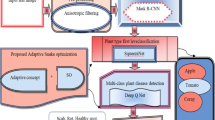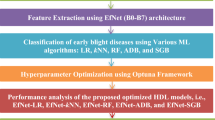Abstract
In recent decades agricultural decision-making system has played a vital role in the field monitoring process. For these emerging technologies like the Internet of Things (IoT), artificial intelligence (AI), and wireless sensors are utilized for precise data extraction and analysis. However numerous techniques are developed for increasing agricultural production and enhancing operational efficiency. But still, they possess various challenges like lack of accuracy, increased power utilization, and costs. Insects and pathogens cause plant diseases that reduce productivity if not diagnosed at a proper time. Thus this paper develops Deep Q Rapidly-exploring Random tree-based Adaptive Fire hawk (DQRR-AFH) for diagnosing leaf diseases and monitoring them. It comprises various phases including data acquisition; Image processing, segmentation, feature extraction, and classification. Further, the classification is performed by exploring random trees, and the hyperparameters are tuned via the Adaptive Fire Hawk Optimizer algorithm is utilized to enhance the efficiency of the model. The proposed method monitors the soil moisture content and prevents cotton leaf diseases by spraying chemicals on the plants. Multiple cotton leaf images are obtained to verify the performance with various metrics. Compared to conventional methods such as WL-CNN, ECPRC, and DT, the proposed model achieved exceptional performance with an accuracy of 98.88%, precision of 97%, and an F1-score of 99.21%.











Similar content being viewed by others
Data availability
No datasets were generated or analysed during the current study.
References
Abdulla M, Marhoon A (2022) Design a mobile application to detect tomato plant diseases based on deep learning. Bull Electr Eng Inform 11(5):2629–2636. https://doi.org/10.11591/eei.v11i5.3918
Ahmed QW, Garg S, Rai A, Ramachandran M, Jhanjhi NZ, Masud M, Baz M (2022) Ai-based resource allocation techniques in wireless sensor internet of things networks in energy efficiency with data optimization. Electronics 11(13):2071. https://doi.org/10.3390/electronics11132071
Castro GGD, Berger GS, Cantieri A, Teixeira M, Lima J, Pereira AI, Pinto MF (2023) Adaptive Path Planning for Fusing Rapidly Exploring Random Trees and Deep Reinforcement Learning in an Agriculture Dynamic Environment UAVs. Agriculture 13(2):354. https://doi.org/10.3390/agriculture13020354
Chan HP, Samala RK, Hadjiiski LM, Zhou C (2020) Deep learning in medical image analysis. Deep Learning in Medical Image Analysis: Challenges and Applications 3–21. https://doi.org/10.1146/annurev-bioeng-071516-044442
Chourasiya S, Gadpale AA, Thethi PS, Nagdeve PD, Wakode P, Indorkar M (2023) Apply machine learning and image processing to detect plant diseases. In: 2023 IEEE International Students' Conference on Electrical, Electronics and Computer Science (SCEECS) 1–5. IEEE. https://doi.org/10.1109/SCEECS57921.2023.10063139
Cresson R (2018) A framework for remote sensing images processing using deep learning techniques. IEEE Geosci Remote Sens Lett 16(1):25–29. https://doi.org/10.1109/LGRS.2018.2867949
Darwish A, Ezzat D, Hassanien AE (2020) An optimized model based on convolutional neural networks and orthogonal learning particle swarm optimization algorithm for plant diseases diagnosis. Swarm Evol Comput 52:100616. https://doi.org/10.1016/j.swevo.2019.100616
Hameed Al-bayati JS, Üstündağ BB (2020) Evolutionary feature optimization for plant leaf disease detection by deep neural networks. Int J Comput Intell Syst 13(1):12–23. https://doi.org/10.2991/ijcis.d.200108.001
Karim S (2021) Cotton leaf disease dataset. Kaggle. https://www.kaggle.com/datasets/seroshkarim/cotton-leaf-disease-dataset. Accessed 27 Mar 2024
Kartikeyan P, Shrivastava G (2021) Review on emerging trends in detection of plant diseases using image processing with machine learning. Int J Comput Appl 975:8887
Kasturi SB, Ellaji CH, Ganesh D, Somasundaram K, Sreedhar B (2023) IoT and Machine Learning Approaches for Classification in Smart Farming. J Surv Fish Sci 10(4S):3373–3385
Kumar S, Sharma B, Sharma VK, Sharma H, Bansal JC (2020) Plant leaf disease identification using exponential spider monkey optimization. Sustain Comput: Inform Syst 28:100283. https://doi.org/10.1016/j.suscom.2018.10.004
Latif G, Abdelhamid SE, Mallouhy RE, Alghazo J, Kazimi ZA (2022) Deep learning utilization in agriculture: Detection of rice plant diseases using an improved CNN model. Plants 11(17):2230. https://doi.org/10.3390/plants11172230
Lloret J, Sendra S, Garcia L, Jimenez JM (2021) A wireless sensor network deployment for soil moisture monitoring in precision agriculture. Sensors 21(21):7243. https://doi.org/10.3390/s21217243
Minopoulos GM, Memos VA, Stergiou CL, Stergiou KD, Plageras AP, Koidou MP, Psannis KE (2022) Exploitation of Emerging Technologies and Advanced Networks for a Smart Healthcare System. Appl Sci 12(12):5859. https://doi.org/10.3390/app12125859
Munawar HS, Hammad AW, Waller ST (2021) A review on flood management technologies related to image processing and machine learning. Autom Constr 132:103916. https://doi.org/10.1016/j.autcon.2021.103916
Nagasubramanian G, Sakthivel RK, Patan R, Sankayya M, Daneshmand M, Gandomi AH (2021) Ensemble classification and IoT-based pattern recognition for crop disease monitoring system. IEEE Internet Things J 8(16):12847–12854. https://doi.org/10.1109/JIOT.2021.3072908
Prodanović R, Rančić D, Vulić I, Zorić N, Bogićević D, Ostojić G, Sarang S, Stankovski S (2020) Wireless sensor network in agriculture: Model of cyber security. Sensors 20(23):6747. https://doi.org/10.3390/s20236747
Raju KL, Vijayaraghavan V (2023) Architecture development with measurement index for agriculture decision-making system using internet of things and machine learning. Multimedia Tools Appl 1–24. https://doi.org/10.1007/s11042-023-14957-2
Saba T, Rehman A, Haseeb K, Bahaj SA, Lloret J (2023) Trust-based decentralized blockchain system with machine learning using Internet of agriculture things. Comput Electr Eng 108:108674. https://doi.org/10.1016/j.compeleceng.2023.108674
Sharma A, Singh PK, Kumar Y (2020) An integrated fire detection system using IoT and image processing technique for smart cities. Sustain Cities Soc 61:102332. https://doi.org/10.1016/j.scs.2020.102332
Shishehgarkhaneh MB, Azizi M, Basiri M, Moehler RC (2022) BIM-based resource tradeoff in project scheduling using fire hawk optimizer (FHO). Buildings 12(9):1472. https://doi.org/10.3390/buildings12091472
Xu J, Gu B, Tian G (2022) Review of agricultural IoT technology. Artif Int Agric 6:10–22. https://doi.org/10.1016/j.aiia.2022.01.001
Zervopoulos A, Tsipis A, Alvanou AG, Bezas K, Papamichail A, Vergis S, Stylidou A, Tsoumanis G, Komianos V, Koufoudakis G, Oikonomou K (2020) Wireless sensor network synchronization for precision agriculture applications. Agriculture 10(3):89. https://doi.org/10.3390/agriculture10030089
Zhang A, Sun M, Wang J, Li Z, Cheng Y, Wang C (2022) Real-Time Data Transmission Scheduling Algorithm for Wireless Sensor Networks Based on Deep Q-Learning. Electronics 11(12):1877. https://doi.org/10.3390/electronics11121877
Funding
None.
Author information
Authors and Affiliations
Contributions
All authors agreed on the content of the study. SLB, ND, JSP and KM collected all the data for analysis. SPJ agreed on the methodology. SLB, ND, JSP and KM completed the analysis based on agreed steps. Results and conclusions are discussed and written together. The author read and approved the final manuscript.
Corresponding author
Ethics declarations
Ethics approval
This article does not contain any studies with human participants.
Human and animal rights
This article does not contain any studies with human or animal subjects performed by any of the authors.
Informed consent
Informed consent was obtained from all individual participants included in the study.
Consent to participate
Not applicable.
Consent for publication
Not applicable.
Competing interests
The authors declare no competing interests.
Additional information
Communicated by: H. Babaie
Publisher's Note
Springer Nature remains neutral with regard to jurisdictional claims in published maps and institutional affiliations.
Rights and permissions
Springer Nature or its licensor (e.g. a society or other partner) holds exclusive rights to this article under a publishing agreement with the author(s) or other rightsholder(s); author self-archiving of the accepted manuscript version of this article is solely governed by the terms of such publishing agreement and applicable law.
About this article
Cite this article
Bharathi, S.L., Deepa, N., Priya, J.S. et al. Innovative agricultural diagnosis: DQRR-AFH algorithm model for effective leaf disease prevention and monitoring. Earth Sci Inform (2024). https://doi.org/10.1007/s12145-024-01276-9
Received:
Accepted:
Published:
DOI: https://doi.org/10.1007/s12145-024-01276-9




